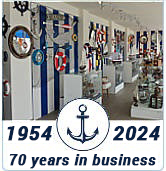Savings will appear in your shopping cart. « Add to Cart on Product Page |
Handcrafted Model Ships customers also shopped

|
|

|
CSS Alabama Limited 32"
CSS Alabama was a screw sloop-of-war built for the Confederate States Navy at Birkenhead, England in 1862 by John Laird Sons and Company of Birkenhead. Alabama served as a commerce raider, attacking Union merchant and naval ships over the course of her two-year career, during which she never laid anchor in a Southern port.
History
Alabama was built by British shipbuilders in 1862. Launched as Enrica, she was fitted out as a cruiser and commissioned August 24, 1862 as CSS Alabama. Under Captain Raphael Semmes, Alabama spent the next two months capturing and burning ships in the North Atlantic and intercepting grain ships bound for Europe. Continuing her path of destruction through the West Indies, Alabama sank USS Hatteras along the Texas coast and captured her crew. After a visit to Cape Town, South Africa, Alabama sailed for the East Indies where the ship spent six months cruising, destroying seven more ships before redoubling the Cape en route to Europe. Many ships attempted a capture, but the Alabama always seemed to vanish into the horizon. All told, the Alabama sunk 62 vessels, mostly merchant ships.
On June 11, 1864, Alabama arrived in Cherbourg, France and Captain Semmes requested permission to dock and overhaul his ship. Pursuing the raider, the American sloop-of-war USS Kearsarge arrived three days later and took up a patrol just outside the harbor. On 19 June, Alabama sailed out to meet Kearsarge. As Kearsarge turned to meet her opponent, Alabama opened fire. Kearsarge waited patiently until the range had closed to less than 1,000 yards (900 m). According to survivors, the two ships steamed on opposite courses moving around in circles as each commander tried to cross the bow of his opponent to deliver a heavy raking fire. The battle quickly turned against Alabama because of the poor quality of her powder and shells, while Kearsarge benefited from the additional protection of chain cables along her sides. A little more than an hour after the first shot was fired, Alabama was reduced to a sinking wreck, causing Semmes to strike his colors and send a boat to surrender. According to witnesses, Alabama fired 150 rounds at her adversary, while Kearsarge fired 100, 5 of which were fired after the Alabama's colors were struck. When a shell fired by Kearsarge tore open a section at Alabama's waterline, water quickly rushed through the cruiser, forcing her to the bottom. Kearsarge rescued the majority of the survivors but forty-one of the Alabama's officers and crew, including Semmes, had to be rescued by the Deerhound, a private yacht, while the Kearsarge stood off and waited for her to sink.
Perhaps the most courageous and selfless act during the Alabama's last moments involved the ship's assistant surgeon, Dr. David Herbert Llewellyn. Dr. Llewellyn, an Englishman, was much loved and respected by the entire crew. During the battle, he steadfastly remained at his post in the wardroom tending the wounded until the order to abandon ship was finally given. As he helped wounded men into the Alabama's only two functional lifeboats, an able bodied sailor attempted to enter one, which was already full. Llewellyn, understanding that the man risked capsizing the craft, grabbed and pulled him back, saying "See, I want to save my life as much as you do; but let the wounded men be saved first." An officer in the boat, seeing that Llewellyn was about to be left aboard the stricken Alabama, shouted "Doctor, we can make room for you." Llewellyn shook his head and replied, "I will not peril the wounded." Tragically, and unknown to the crew, Llewellyn had never learned to swim, and he drowned when the ship went down.
His sacrifice did not go unrecognized. The Confederacy awarded him posthumously the Confederate Medal of Honor. In his native Wiltshire, a memorial window and tablet were placed at Easton Royal Church. Another tablet was placed in Charing Cross Hospital, where he attended medical school.
Repercussions
During her two-year career as a commerce raider, Alabama had caused disorder and devastation across the globe for United States merchant shipping. The Confederate cruiser claimed more than 60 prizes valued at nearly $6,000,000. In an important development in international law, the U.S. Government pursued the "Alabama Claims" against the British Government for such devastation, and following a court of arbitration, won heavy damages.
The wreck
In November 1984, the French Navy mine hunter Circé discovered a wreck under nearly 60 m (200 ft) of water off Cherbourg The location of the wreck (WGS84) was 49°45'147N / 001°41'708W. Captain Max Guerout later confirmed the wreck to be the Alabama's remains.
In 1988, a non-profit organization, the Association CSS Alabama, was founded to conduct scientific exploration of the shipwreck. Although the wreck resides within French territorial waters, the U.S. government, as the successor to the former Confederate States of America, is the owner. On October 3, 1989, the United States and France signed an agreement recognizing this wreck as an important heritage resource of both nations and establishing a Joint French-American Scientific Committee for archaeological exploration. This agreement established a precedent for international cooperation in archaeological research and in the protection of a unique historic shipwreck. This agreement will be in effect for five years and is renewable by mutual consent.
The Association CSS Alabama and the U.S. Navy/Naval Historical Center signed on March 23, 1995 an official agreement accrediting Association CSS Alabama as operator of the archaeological investigation of the remains of the ship. Association CSS Alabama, which is funded solely from private donations, is continuing to make this an international project through its fund raising in France and in the United States, thanks to its sister organization, the CSS Alabama Association, incorporated in the State of Delaware.
In 2002, a diving expedition raised the ship's bell along with more than 300 other artifacts, including cannons, structural samples, tableware, ornate commodes, and numerous other items that reveal much about life aboard the Confederate warship.
"Roll Alabama, roll!"
The Alabama is the subject of a well known sea shanty, '"Roll Alabama, roll'":
- When the Alabama's Keel was Laid, (Roll Alabama, roll!), 'Twas laid in the yard of Jonathan Laird (Roll, roll Alabama, roll!)
- 'Twas Laid in the yard of Jonathan Laird, 'twas laid in the town of Birkenhead.
- Down the Mersey way she rolled then, and Liverpool fitted her with guns and men.
- From the western isle she sailed forth, to destroy the commerce of the north.
- To Cherbourg port she sailed one day, for to take her count of prize money.
- Many a sailor laddie saw his doom, when the Kearsarge it hove in view.
- When a ball from the forward pivot that day, shot the Alabama's stern away.
- Off the three-mile limit in '64 the Alabama was seen no more.
"Daar Kom die Alibama"
The Alabama's visit to Cape Town in 1863 has passed (with a slight spelling change) into South African folklore in the Afrikaans song, '"Daar Kom die Alibama'":
- Daar kom die Alibama,
- Die Alibama die kom oor die see,
- Daar kom die Alibama,
- Die Alibama die kom oor die see...
- There comes the Alabama,
- The Alabama that comes oer the sea,
- There comes the Alabama,
- The Alabama that comes oer the sea.
Battle Ensigns
The first part of the cruise of CSS Alabama had the raider flying the 1st National Flag of the Confederacy as its battle ensign. It was under this flag that the Alabama sank the Warship USS Hatteras off Galveston, Texas.
In late 1863, the new naval ensign (based on the 2nd National Flag of the Confederacy) was used (probably made locally after reading news articles or dispatches regarding the new design). It lasted until its sinking off Cherbourg, France, in 1864. At the close of the battle (between CSS Alabama and USS Kearsarge, the Alabama's Battle ensign was struck. It is not known what happened to this flag after the battle.





 Handcrafted Model Ships
Handcrafted Model Ships















